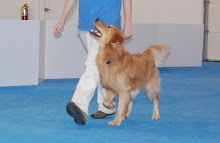There are a few ways to get speed for any type of behavior... here are the five I hear most often.
- Train when the dog is already more energetic.
- Selectively reinforce the responses with most speed/the moments of greatest speed/the act of increasing speed. Theoretically, speed will be increasing over time.
- Prompt the dog to increase speed
- Speed will come once the behavior is fluent.
- Placement of reinforcer
Like most things in dog training, there isn't one right answer, but there are some things that work better than others and there are some things that are wrong.
Speed will come when the behavior is fluent: This was a huge change in my training. 6 years ago, I taught Luna to weave using a variation of 2x2.... and unlike the "real" thing (that wasn't available in DVD form at that point...!), speed was not one of my early criteria. Luna learned to weave. And she could eventually weave at class. Up to the 12 required poles. When she was more excitable, when she was more fluent, she did go faster. She moved with a bigger stride and then started running into poles or skipping poles and getting unhappy. She went back to her slower weaving. The act of weaving quickly, with speed, was physically different than weaving slowly. It required a different number of steps, different size of steps, and different way of moving. I hadn't taught her to do that and she wasn't able to learn it on her own.
IF the behavior is a specific motor skill; weave poles or a contact behavior... I now make speed a criteria from very early on.
Shape for Increased Speed: There are some behaviors where this works better than others and there are teams who have greater success with this piece of criteria. In my experience, unless there is a very specific "click point" for how to see the dog increasing speed.... it's too much guesswork and not precise enough.
Placement of Reinforcer: Obviously this is my favorite! Throwing, chasing, play type reinforcers can help increase speed. Where the reinforcer is tossed can impact the direction and type of speed as well. Working on fast recalls? Run! Feed the dog for catcihng up. Working on go out speed? Once your dog is leaving you.... toss treats and toys out ahead. Turns after a jump? Throw the toy or treats in that direction.
Prompt the Dog for Increased Speed: This is another of my most favorite moments from the Agility Right From the Start book. They have a specific strategy they call "Race to Reward." We do variations of this in training group and training class. We manufacture speed with a treat/toy person (who also can choose not to reinforce if for reason something goes wrong!). We build up speed from the beginning. We teach the dog how to perform with speed. The --huge-- advantage with this strategy is that, from the time the dog learns to do the race to reward with speed.... you aren't getting as many slow responses. You aren't reinforcing slow responses. The dog doesn't have a history of reinforcement for slow responses.




No comments:
Post a Comment